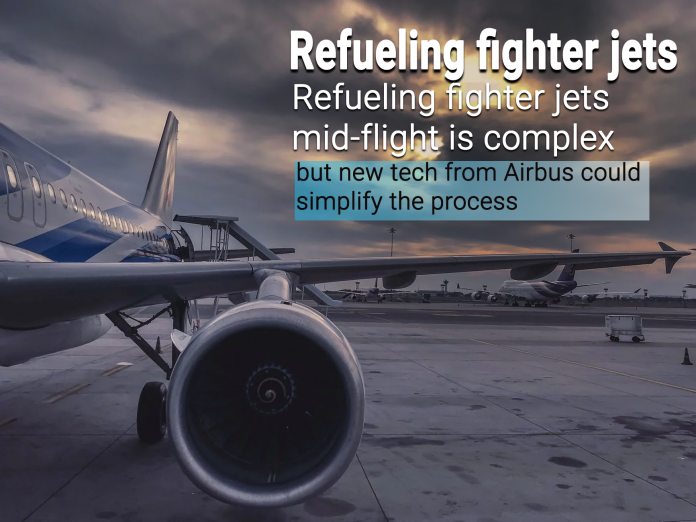Refueling fighter jets mid flight is complex, but new tech from Airbus could simplify the process
Refueling fighter jets mid flight is complex. Imagine filling your car with gasoline as you’re cruising down the highway. Oh, and the fuel is flowing from a tanker truck speeding in front of you. That’s something like what combat pilots have to contend with when refueling while airborne.
The maneuver is known as air-to-air refueling (AAR), in-flight refueling, or even just tanking. It plays a vital role in extending the range of fighter planes, and it saves air forces precious time by enabling their planes to cover vast distances without needing to land in possibly unfriendly countries. In the 1990 Gulf War, for example, F-15 fighter jets flew 14-hours non-stop from Virginia to Kuwait—with seven AARs en-route!Refueling fighter jets mid flight is complex.

Important Announcement – EasyShiksha has now started Online Internship Program “Ab India Sikhega Ghar Se”

And just recently, Airbus announced that it had completed, for the first time, a step towards “automatic” air refueling—more on that breakthrough down below.
The exercise has a colorful history. The first airborne refueling occurred in 1921 between two biplanes. With a five-gallon fuel canister and at an altitude of some 1,000 feet, Wesley May worked his way down the right wing of a plane flown by Frank Hawks; he then climbed onto the left wing of another plane and eventually poured the fuel into its gas tank. Although an impressive stunt, it did obviously not represent a practical way to refuel while airborne. So, on June 27, 1923, the US Army Air Service used two Airco DH-4B biplanes to try out a less extreme approach. The refueling aircraft released a fueling hose that did the deed.
Top Courses in Software Engineering
The tech allows the boom operator to simply activate the system and then supervise while the computer takes control of the boom, maintaining the right angle and distance to fly it to within centimeters of the receiver aircraft. The boom’s telescope is then extended into the receiver, the fuel transferred, then automatically disconnected and the boom brought away.
It’s easy to wonder what would happen if there was a problem during an in-flight refueling, whether it’s automated or not. But surprisingly, things don’t often go wrong, and there have been remarkably few serious accidents.
Both aircraft were lost and seven people were killed in the accident. One bomb was recovered from a depth of 2,900 feet in the Mediterranean; the other three landed near Palomares, Spain, two of them detonating and scattering plutonium around the area.
For more information related to technology, visit: HawksCode and EasyShiksha
Empower your team. Lead the industry
Get a subscription to a library of online courses and digital learning tools for your organization with EasyShiksha
Request NowQ. Are EasyShiksha's internships truly free?
Yes, all internships offered by EasyShiksha are completely free of charge.
Q. How can I apply for an internship with EasyShiksha?
You can apply by visiting our website, browsing available internships, and following the application instructions provided.
Q. What types of internships are available through EasyShiksha?
EasyShiksha offers a wide range of internships across technology, business, marketing, healthcare, and more. Opportunities are continuously updated.
Q. Will I receive a certificate upon completing an internship?
Yes, upon successful completion, you will receive a certificate recognizing your participation and achievements.
Q. Are EasyShiksha's internship certificates recognized by universities and employers?
Yes, the certificates are recognized by universities, colleges, and employers worldwide.
Q. Is the download of certificates free or paid?
Access to internships and courses is free, but there is a small fee to download certificates, covering administrative costs.
Q. When can I start the course?
You can choose any course and start immediately without delay.
Q. What are the course and session timings?
These are fully online courses. You can learn at any time and pace. We recommend following a routine, but it depends on your schedule.
Q. What will happen when my course is over?
After completion, you will have lifetime access to the course for future reference.
Q. Can I download the notes and study material?
Yes, you can access and download course materials and have lifetime access for future reference.
Q. What software/tools would be needed for the course?
All necessary software/tools will be shared during the training as needed.
Q. I’m unable to make a payment. What should I do?
Try using a different card or account. If the problem persists, email us at info@easyshiksha.com.
Q. Do I get the certificate in hard copy?
No, only a soft copy is provided, which can be downloaded and printed if required.
Q. The payment got deducted but shows “failed”. What to do?
Technical errors may cause this. The deducted amount will be returned to your account in 7-10 working days.
Q. Payment was successful but dashboard shows ‘Buy Now’?
Sometimes payment reflection is delayed. If it takes longer than 30 minutes, email info@easyshiksha.com with the payment screenshot.
Q. What is the refund policy?
If you face technical issues, you can request a refund. No refunds are issued once the certificate has been generated.
Q. Can I enroll in a single course?
Yes, select the course of interest, fill in the details, make payment, and start learning. You will also earn a certificate.
Q. My questions are not listed above. I need further help.
Contact us at info@easyshiksha.com for further assistance.
I hope you like this blog, Refueling fighter jets mid flight is complex.
ALSO READ: missfilmy
Get Course: Become-an-Influencer-on-Social-Media



































































